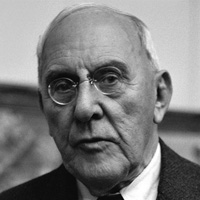
Josef Hoffmann (1870 - 1956) studied architecture under Carl von Hasenquer and Otto Wagner at the Academy of Fine Arts in Vienna. In 1899, he became a professor at what is now the University of Applied Arts Vienna. In 1903, he and Kolo Moser established the Wiener Werkstätte. His first important building, the sanatorium in Purkersdorf, near Vienna, built in 1904, set radical new standards in architecture and interior design. Yet it was the Palais Stoclet in Brussels, built between 1905 and 1911, that cemented his international reputation. It was with this project that Josef Hoffmann succeeded in his "Gesamtkunstwerk" (translated from German as "total work of art") where he aestheticized all aspects of design. Josef Hoffmann's formal language is primarily characterized by its strict geometrical lines, a search for simplicity, and the typical reduction of color to black and white. He overcame the duality of tradition and modernity and created works that are valid to this day. Austrian manufacturer, Wittmann, is the licensed manufacturer of Hoffmann's enduring designs.
+ View Filters
-
Alleegasse Lounge Chair
by Josef Hoffmann
for Wittmann -
Alleegasse Sofa
by Josef Hoffmann
for Wittmann -
Club 1910 Lounge Chair
by Josef Hoffmann
for Wittmann -
Club 1910 Sofa
by Josef Hoffmann
for Wittmann -
Fledermaus Dining Chair
by Josef Hoffmann
for Wittmann -
Haus Koller Lounge Chair
by Josef Hoffmann
for Wittmann -
Haus Koller Sofa
by Josef Hoffmann
for Wittmann -
Kubus Lounge Chair
by Josef Hoffmann
for Wittmann -
Kubus Sofa
by Josef Hoffmann
for Wittmann -
Palais Stoclet Lounge Chair
by Josef Hoffmann
for Wittmann -
Palais Stoclet Sofa
by Josef Hoffmann
for Wittmann -
Salon Lounge Chair
by Josef Hoffmann
for Wittmann -
Salon Sofa
by Josef Hoffmann
for Wittmann -
Satztische Nesting Tables
by Josef Hoffmann
for Wittmann -
Villa Gallia Lounge Chair
by Josef Hoffmann
for Wittmann -
Villa Gallia Sofa
by Josef Hoffmann
for Wittmann
















